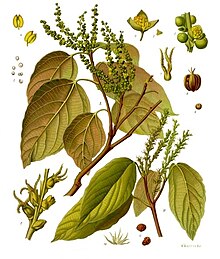Mallotus (plant): Difference between revisions
KolbertBot (talk | contribs) m Bot: HTTP→HTTPS (v481) |
m Task 3: +{{Taxonbar|from=Q1205104}} (8 sig. taxon IDs); WP:GenFixes using AWB |
||
| Line 42: | Line 42: | ||
[[Image:Mallo mollis 170808-5307819 cmp.JPG|thumb|120px|''[[Mallotus mollissimus]]'']] |
[[Image:Mallo mollis 170808-5307819 cmp.JPG|thumb|120px|''[[Mallotus mollissimus]]'']] |
||
[[Image:Mallo panic 110212-12210 cmp.JPG|thumb|120px|''[[Mallotus paniculatus]]'']] |
[[Image:Mallo panic 110212-12210 cmp.JPG|thumb|120px|''[[Mallotus paniculatus]]'']] |
||
'''''Mallotus''''' is a genus of the spurge family [[Euphorbiaceae]] first described as a genus in 1790.<ref>[https://www.biodiversitylibrary.org/page/654294#page/247/mode/1up Loureiro, João de. 1790. Flora Cochinchinensis 601, 635]</ref> Two [[species]] (''[[Mallotus oppositifolius|M. oppositifolius]]'' and ''[[Mallotus subulatus|M. subulatus]]'') are found in [[tropical]] [[Africa]] and [[Madagascar]]. All the other species are found in [[East Asia|East]], the [[Indian Subcontinent]], [[Southeast Asia]], eastern [[Australia]], and certain islands of the western [[Pacific Islands|Pacific]].<ref name=n/><ref>[http://www.efloras.org/florataxon.aspx?flora_id=2&taxon_id=119552 Flora of China Vol. 11 Page 225 <big>野桐属</big> ye tong shu ''Mallotus'' Loureiro, Fl. Cochinch. 2: 635. 1790. ]</ref><ref>Govaerts, R., Frodin, D.G. & Radcliffe-Smith, A. (2000). World Checklist and Bibliography of Euphorbiaceae (and Pandaceae) 1-4: 1-1622. The Board of Trustees of the Royal Botanic Gardens, Kew.</ref><ref>Sierra, S.E.C. & Van Welzen, P.C. (2005). A taxonomic revision of ''Mallotus'' section ''Mallotus'' (Euphorbiaceae) in Malesia. Blumea 50: 249-274. |
'''''Mallotus''''' is a genus of the spurge family [[Euphorbiaceae]] first described as a genus in 1790.<ref>[https://www.biodiversitylibrary.org/page/654294#page/247/mode/1up Loureiro, João de. 1790. Flora Cochinchinensis 601, 635]</ref> Two [[species]] (''[[Mallotus oppositifolius|M. oppositifolius]]'' and ''[[Mallotus subulatus|M. subulatus]]'') are found in [[tropical]] [[Africa]] and [[Madagascar]]. All the other species are found in [[East Asia|East]], the [[Indian Subcontinent]], [[Southeast Asia]], eastern [[Australia]], and certain islands of the western [[Pacific Islands|Pacific]].<ref name=n/><ref>[http://www.efloras.org/florataxon.aspx?flora_id=2&taxon_id=119552 Flora of China Vol. 11 Page 225 <big>野桐属</big> ye tong shu ''Mallotus'' Loureiro, Fl. Cochinch. 2: 635. 1790. ]</ref><ref>Govaerts, R., Frodin, D.G. & Radcliffe-Smith, A. (2000). World Checklist and Bibliography of Euphorbiaceae (and Pandaceae) 1-4: 1-1622. The Board of Trustees of the Royal Botanic Gardens, Kew.</ref><ref>Sierra, S.E.C. & Van Welzen, P.C. (2005). A taxonomic revision of ''Mallotus'' section ''Mallotus'' (Euphorbiaceae) in Malesia. Blumea 50: 249-274.</ref> |
||
==Fossil record== |
==Fossil record== |
||
| Line 253: | Line 253: | ||
==References== |
==References== |
||
{{ |
{{Reflist}} |
||
{{Taxonbar|from=Q1205104}} |
|||
{{DEFAULTSORT:Mallotus (Plant)}} |
{{DEFAULTSORT:Mallotus (Plant)}} |
||
[[Category:Mallotus (plant)| ]] |
[[Category:Mallotus (plant)| ]] |
||
Revision as of 03:46, 23 March 2018
| Mallotus | |
|---|---|

| |
| Kamala Tree (M. philippensis)[1] | |
| Scientific classification | |
| Kingdom: | |
| (unranked): | |
| (unranked): | |
| (unranked): | |
| Order: | |
| Family: | |
| Subfamily: | |
| Tribe: | |
| Subtribe: | |
| Genus: | Mallotus |
| Synonyms[2] | |
| |




Mallotus is a genus of the spurge family Euphorbiaceae first described as a genus in 1790.[3] Two species (M. oppositifolius and M. subulatus) are found in tropical Africa and Madagascar. All the other species are found in East, the Indian Subcontinent, Southeast Asia, eastern Australia, and certain islands of the western Pacific.[2][4][5][6]
Fossil record
Mallotus macrofossils have been recovered from the late Zanclean stage of Pliocene sites in Pocapaglia, Italy.[7]
Uses
Mallotus species are used as food plants by the larvae of some Lepidoptera species including Endoclita malabaricus. The Kamala tree (Mallotus philippensis) has hairs of whose seed capsule which are the source of a yellow dye (kamala dye) and (formerly) herbal remedy.
Species[2]
Formerly included[2]
moved to other genera (Acalypha Aleurites Blumeodendron Chondrostylis Cleidion Croton Discocleidion Endospermum Hancea Lasiococca Macaranga Melanolepis Neoboutonia Plukenetia Ptychopyxis Rockinghamia Spathiostemon Sumbaviopsis )
References
- ^ 1897 illustration from Franz Eugen Köhler, Köhler's Medizinal-Pflanzen
- ^ a b c d Kew World Checklist of Selected Plant Families
- ^ Loureiro, João de. 1790. Flora Cochinchinensis 601, 635
- ^ Flora of China Vol. 11 Page 225 野桐属 ye tong shu Mallotus Loureiro, Fl. Cochinch. 2: 635. 1790.
- ^ Govaerts, R., Frodin, D.G. & Radcliffe-Smith, A. (2000). World Checklist and Bibliography of Euphorbiaceae (and Pandaceae) 1-4: 1-1622. The Board of Trustees of the Royal Botanic Gardens, Kew.
- ^ Sierra, S.E.C. & Van Welzen, P.C. (2005). A taxonomic revision of Mallotus section Mallotus (Euphorbiaceae) in Malesia. Blumea 50: 249-274.
- ^ Messian to Zanclean vegetation and climate of Northern and Central Italy by Adele Bertini & Edoardo Martinetto, Bollettino della Societa Paleontologica Italiana, 47 (2), 2008, 105-121. Modena, 11 lugio 2008.
